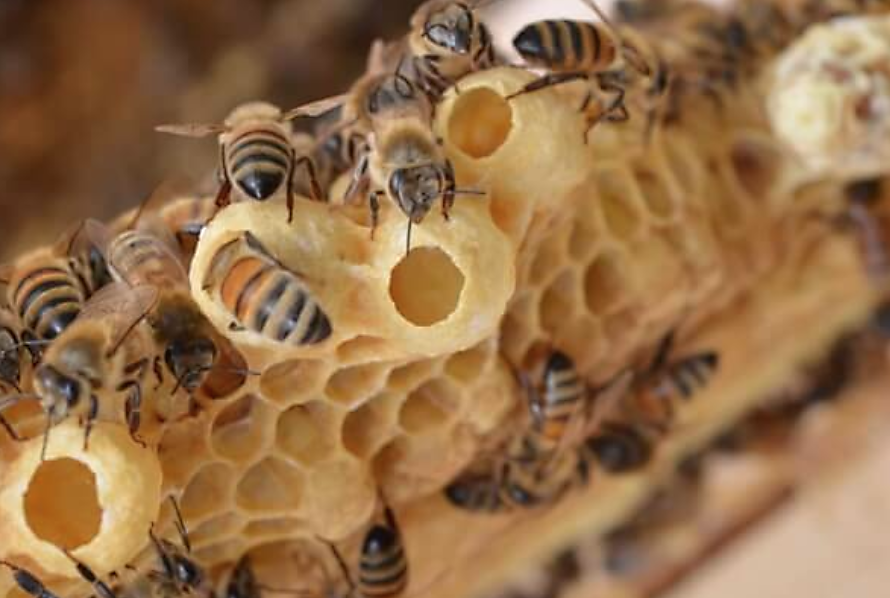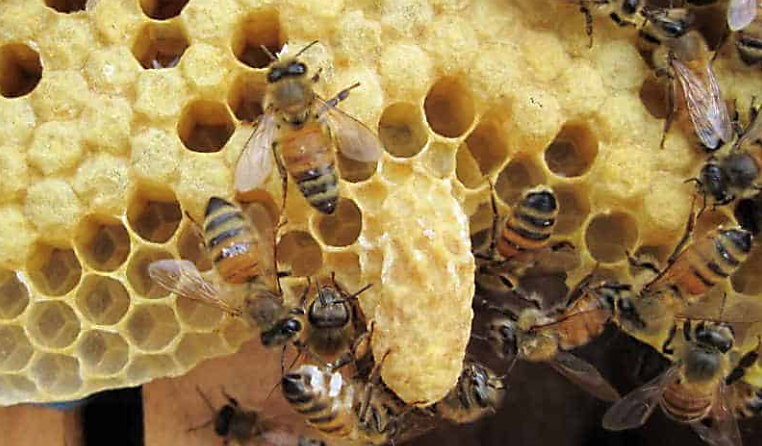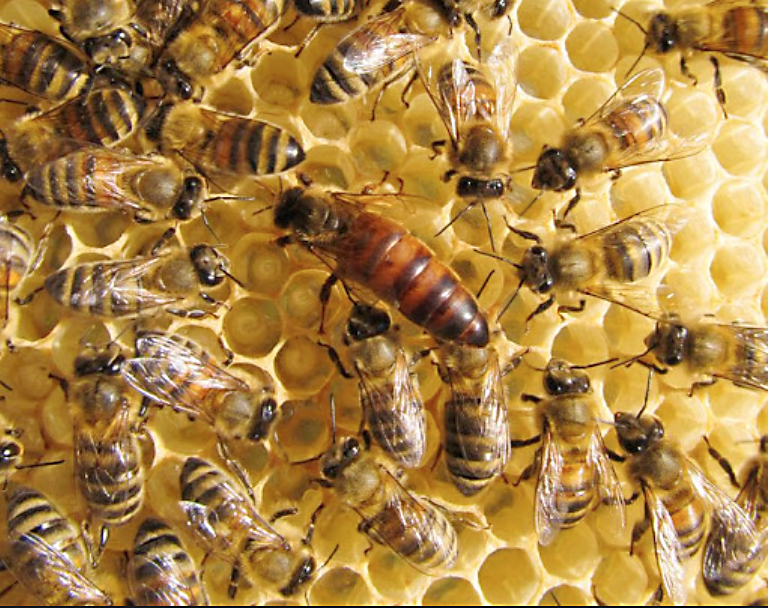About Honeybees
ABOUT THE HONEYBEE
And here she is in all her glory - head down, filling a cell with nectar. Well I say filling… I should say “contributing.” Did you know, in a honeybees life time, she only produces 1/12th teaspoon of honey? Just think about that for a moment, ask yourself next time you buy a jar of honey, how many honeybees does it take to make a single 454g jar of honey? It’s a question I’m often asked when giving my talks. This is very difficult to calculate as it depends on how much nectar each honeybee is bringing back to their hive! So it’s easier to ask, how many trips to a nectar producing flower do they have to make in order to fill a 454g jar of honey? The answer is, approximately 25,000 and they have flown up to 55,000 miles. Impressed? Read on…
Ok, so a single honeybee cannot make that many journeys in her lifetime because… well, I guess the next question should be - how long is a honeybees life time?
In the late spring and summer, when the weather is warm and they’re busy collecting everything they need for their colonies’ wellbeing and subsequent survival of their species, they live for about 6 weeks. The first three weeks of a worker bees life is spent inside the hive, working while developing their wings and stings and the next three weeks are spent flying/foraging. They literally work themselves to death. All this they do for their colony. They don’t live long enough to benefit from any of the work they do. In fact, if they can, they even die outside of the hive in order to leave the much needed space for the next generation of bees. During the winter they can live up to 5 months. The reason for this is simple - they are doing much less work. They don’t normally fly when the weather is under 16°. Their job during the winter is solely to look after the queen who stops laying during the late autumn and winter. They keep her safe, warm and fed ready for the spring when she will start to lay again and build up their colony.
I mentioned in the paragraph above, the first three weeks of the worker bees life is spent ‘working’ while developing their stings and wings. I hope that begged the question “worker bee?” You see, in a hive there are three different honeybees. The queen bee, there is only one queen per hive. The drone bees; these are the male bees and they make up about 10% of the hive. And, the worker bees. These are the girls. So lets roll with that for a moment and I’ll start with the queen.
The queen: She is, it could be argued, the most important bee in the colony. Why ‘could be argued?’ Because she is not! Read on and you will find out why each and every honeybee in a colony is important. Her job is to lay the eggs that guarantee the survival of the species. She lays about 2,000 eggs a day by the way! She also uses pheromones, a chemical substance produced and released into the hive that affects the behaviour of the rest of the colony. She is bigger than all the honeybees and this is because, when the worker bees are creating a new queen for their colony they build larger cells, (queen cups we beekeepers call them), and once the existing queen lays an egg in each cup they only feed those eggs with royal jelly. The workers then build out the cup to become a much larger cell in order house their future queen and after nine days they will close it up. After sixteen days the queen is born, she makes a tooting sound to alert the workers, drones and other potential queens of her arrival, and yes I have actually heard this. The other queens, still in their cells, make a quacking sound, (no I haven’t heard this), to let the queen know where they are. Someone needs to tell them not to do this because she then goes around and stings them all to ensure she is the only queen in the colony! If one or two escape her notice they will fight until only one survives. Now the colony know they have a good strong queen. But hang on, “stings all the other potential queens?” You thought honeybees die when then sting. Well they do, but not the queen. Her sting is smooth, not barbed, so she can use it repeatedly, which she does to ensure her survival. But she only uses it in that way to kill her potential rivals. She also uses it to make sure her eggs are nicely positioned in the centre of each cell. Clever bees. Ok, she’s ensured her survival. She is larger than the other bees and has smaller wings by comparison. She will spend a few days familiarising herself with her fellow honeybees and then go out on an orientation flight. Her next exit from the hive is to go out and mate with some drones. She will mates with up to 20 drones and then returns to the colony and starts her life long mission of laying around 2,000 eggs a day. The only other time the queen will leave the hive is if the colony decides it’s too crowded and needs more space or if the queen is no longer laying enough for them. When this happens the workers will starve her for about three days so she loses weight and is able to fly. She knows when her time is up and she’ll take off with half the colony, the flying bees, who will lead her to a temporary spot while some of them go out looking for a new permanent home. The queen bee can live for up to 5 years.
QUEEN CUP • QUEEN CELL • QUEEN BEE • SWARM
The drones. As I said earlier, the drones make up roughly 10% of a colony of honeybees. At this point I should tell you that, during the height of the summer, a colony of bees consists of anything up to 60,000 honeybees, depending on the type of hive you have. During the winter months the colony reduces down, because the queen stops laying, to about 10,000 none of which are drones. Why? Good question. The drones are the male bees. They are larger than the worker bees, with a boxy shape body, larger eyes and wings. Their sole purpose in life is to mate with the queen. Hundreds/nay thousands of them can gather in a ‘drone congregation area’ -(DCA) - and compete with each other to mate. They don’t fight, it’s the drones that manage to get nearest to the queen who are successful in their quest. after which they die. I know, not much of a reward for their efforts is it? Their appendage is actually inside them and therefore after mating, I’m afraid it is ripped away and he dies. The other drones return to a hive, they have no loyalty to their own hive and spend the rest of their lives pootling around eating honey! The life span of a drone? About three to five weeks.
The worker bees. The females. Yes all the worker bees are girls. They are the smallest bees in the hive and we call them workers simply because they work every single day of their lives for the good of and the continuation of their colony and species. Everything they do is completely selfless. They do not live long enough to benefit from their work. From the day they are born to the day they die, they have various jobs to do inside and outside of the hive. I’ll begin with the house bees, so called because they have not yet left the hive!
Nurse bees: When a honeybee is born she cleans out her cell and then takes on the task of feeding the larvae. They also feed the young drones as they aren’t capable of feeding themselves.
Undertaker: (From 3 days) The undertaker takes any dead bees out of the hive and will take them as far away as she can just in case they are diseased.
Attendants to the queen: (From 7 days) They feed and groom the queen and spread a particular phereomone, Queen Mandibular Pheromone (QMP), which tells the other bees in the hive that the queen they have is still viable.
Architects: (From 12 days) Honeybees produce wax. They have eight wax glands underneath their abdomens from which they produce tiny flakes of wax. They use this to build out the honeycombs, seal the honey and cover the brood and stores.
Fanning bees: (From 12 days) The fanning bees are the hives air conditioning! They use their wings along with water to cool down the hive. They also use their wings to warm up the hive in cooler and colder months. And, they use their wings to reduce the amount of water in the nectar that turns it into honey… Clever bees… a saying I use a lot!
Guard Bees: (From 18 days) This is the last job the honeybee has before it becomes a flying bee, a forager bee. She stands or hovers at the entrance of the hive ensuring that no predators, or robber bees enter the colony. A honeybee’s sting is at it’s most venomous when she is a guard bee.
And so we come to the flying bee. The little bee you see in your garden, flitting from flower to flower in your trees and amongst your blossoming shrubs and you think to yourself what a wonderful and simple life they have! First let me tell you that these tiny little creatures will fly up to 5 miles to gather all they need for their colony. Consider that next time you can’t be bothered to walk to the local shop! They too have various jobs.
Collecting pollen: As the honeybee hops from flower to flower, (they stick to one shrub or tree otherwise we would have cross pollination - can I say it again? Clever bees…), she picks up pollen on her body which transfers to other plants which of course we know is pollination, but she also gathers the pollen up on her back legs which form large baskets that she then carries back to the hive where it is packed into cells and mixed with nectar which helps preserve it.
Collecting nectar: A honeybee has two stomachs, one of which is for storing the nectar. She has a long straw like tongue, (proboscis), which she uses to draw up the nectar from the base of a flower. She takes it back to the hive and the house bee, using her proboscis, takes it from her and stores it in the cells ready to be turned into honey.
Collecting propolis: Propolis is the sticky substance collected from the resin of trees and leaf buds. The honeybee collects this on her back legs, like the pollen collector but she has to have help to unload her cargo as it is so sticky! It’s mixed with wax and honey and other enzymes from their stomachs to produce the very useful substance we call propolis. ‘Useful’ you say? Yes - very. It’s used to seal up their hive so no cold air can get in or warm air escape, and the same applies to predators. They also coat the entrance of their hive with it. I also call propolis bee penicillin as it has strong anti bacterial qualities which helps prevent the growth of any bacteria or fungus that would otherwise thrive in a warm humid environment. It’s also used to wrap up any dead intruder to prevent it’s decay having an effect on the hive.
Interesting fact about propolis. It is derived from two greek words ‘pro’ meaning front of, at the entrance to and ‘polis’ meaning ‘before the city’ or ‘in defense of the city’ Use that bit of information in your next quiz night… you’re welcome.
Collecting Water: The honeybee collects water in a special place in their stomach called a ‘crop’. They store it there and take it back to the hive where they give it to one of the house bees who disperses it along the edges of the frames or on top of the abdomens of the fanning bees who use their wings to cool the hives down. They also need it for drinking as do we.
And so there it is, just a the tip of the iceburg in the world of our wonderful little honeybee, or the ‘Honourable Honeybee’ as I now like to call her. There’s so much more to her than meets they eye. I will leave you with a part of a wonderful talk given by a gentleman called Ted Dennard who runs The Savannah Bee Company https://savannahbee.com (check it out - it’s lovely by the way). When I heard this I had to write it down as it probably encapsulates all that I love about the honeybees, I hope it resinates with you as much as it did with me…
THE HONOURABLE HONEYBEE
“The little honeybee is about 100 million years old. It is one of the most ancient and noble of species. They are natures natural gardeners. Flowers have not developed their colours for us, they have done it for the honeybees. They work their whole lives, using one interaction at a time, to change the world for the better.
What if we as a species could emulate the honourable honeybee. It starts with our next interaction, with the environment, business, the person you’re sitting next to and the next person you meet. What if we could find a sustainable way to help humanity, live continue and prosper. It’s admirable and achievable. Let’s not destroy in 100 years what the bees have spent 100 million years making.
Maybe, perhaps, we cannot just save the bees, but save the world and ourselves.”
(Ted Dennard)
If any of the above has tickled your taste buds and left you wanting to know more about the honeybees then go to Contact page and book me to come to your school, library, local community or business because that is what I do. I go around spreading the word and “Creating A Buzz About The Honeybee”







